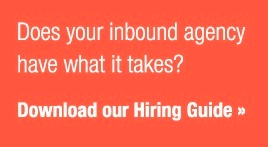 We greet you today with good news. Designing an inbound marketing funnel, in and of itself, isn't entirely difficult. As we'll soon see, the model is readily available and can be easily adopted. The trick isn't designing it as much as feeding it with consistent and compelling content and tools for conversion that align to each stage of the funnel. But don't worry; we'll talk about that part as well.
We greet you today with good news. Designing an inbound marketing funnel, in and of itself, isn't entirely difficult. As we'll soon see, the model is readily available and can be easily adopted. The trick isn't designing it as much as feeding it with consistent and compelling content and tools for conversion that align to each stage of the funnel. But don't worry; we'll talk about that part as well.
First off let's look at the composition of the actual funnel. Hubspot pioneered the concept of the inbound marketing funnel — though other inbound marketing firms adhere to similar models — so we'll use them as a reference point. As you'll see here, the funnel consists of four main stages. (You'll also note that unlike the classic outbound funnel, the inbound model is presented horizontally, rather than vertically.)
The first stage, Attract, aims to draw strangers to your brand, so you need to roll out activities that align to this goal. These include blogs, social media, keywords, and Web pages. As you can imagine, each of these elements can be complicated undertakings in their own right, worthy of separate blog posts. Yet rather than drill deeply into each one, we'll try and underscore the common ingredients that can ensure success.
The first common ingredient is having a deep understanding of your buyer personas. Your buyer personas are the foundation of your inbound marketing funnel — get them wrong, and the whole process can fall apart. Get a precise idea of customer and lead demographics, interests, concerns, and where they spend most of the social media time (e.g. Facebook vs. Pinterest).
The overarching goal at the Attract phase is to exude professionalism and expertise. Don't actively sell products or services but instead convey the idea that your brand can be trusted. The goal is to intrigue strangers such that they visit your site and become — you guessed it — "visitors," investigate your services, and hopefully make their way to the next phase of the funnel, which is Convert.
The goal of the Convert phase is to transform visitors into leads by rolling out and optimizing a distinct set of tools that include Calls to Action, Landing Pages, Forms, and Contacts.
As with the Attract phase, each of these tools should be designed carefully and with an eye towards analytical measurement. But at a higher level, a common theme also applies: gather lead information with minimal friction or intrusion. These tools should be aesthetically integrated with your site, well written, and provide a distinct service or deliverable without confusing the lead. And as always, these deliverables should be aligned with the lead's buyer persona.
Next up: turning leads into customers in the Close phase. The tools here include email, workflows, lead scoring, and CRM integrations. Here is where elements of the funnel become more automated and precise. For example, you'll have better understanding of lead's unique interests, enabling you to roll out a focused eBlast.
The key element of this phase is realizing that leads, at this late stage, trust your brand. So instead of trying to exude expertise, your team and the marketing plan needs to identify obstacles to conversion — price point vs. value — and address these obstacles accordingly via, say, a free consultation or estimate.
Last but not least, your customers enter the final phase in the inbound funnel — Delight — where, by making them happy, you turn them into "promoters" for your brand. You accomplish this via social media, smart calls to action, email, and workflows. Identify satisfied customers and encourage them to share their experience. By doing so, these positive testimonials help to Attract — that's phase one in the funnel for those keeping track at home — "strangers" to your brand.
And just like that, the fun begins all over again.
What do you think? What are the biggest challenges towards creating an effective inbound funnel? What elements of this process did we neglect to mention?





